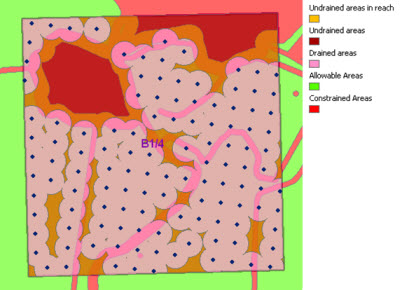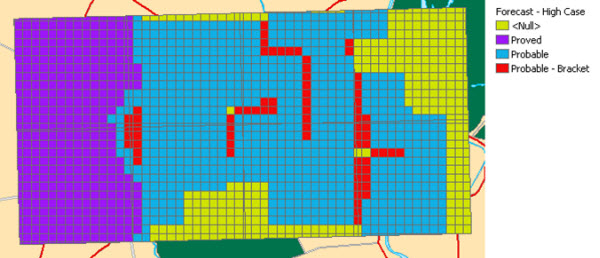Exciting times here at Exprodat as we prepare to release a new software tool for the “unconventionals” market. In anticipation of this I thought I’d provide a sneak preview of what’s coming…
Unconventionals Analyst is a well planning and reserve forecasting application for unconventional resource projects. Unconventionals Analyst was developed in partnership with a leading global integrated natural gas company and has been used on development projects for over a year, which is quite a stamp of approval. Like other Exprodat software the application is an ArcGIS Desktop extension, and was developed to solve specific problems encountered when developing unconventional fields.
Drilling Constraint Analysis and Well Pattern Planning
Unconventionals Analyst has tools for generating an optimal drilling pattern for an area, taking into account the required orientation of the pattern, surface drilling constraints, and locations where it has been decided that a well must be placed. The tools allow field development teams to create multiple well patterns, and calculate an ’efficiency’ for each. Field developers can then select the most efficient well pattern and make modifications manually, re-calculating the efficiency afterwards to validate the changes.

Reserve Forecasting
When planning any development it is essential to know the reserve volumes available, so Unconventionals Analyst also has tools for estimating and forecasting reserves using a grid-based reserves classification method used by many operators to evaluate unconventional resources. This grid-based method divides the area into cells sized according to a drill space unit (DSU), with each cell in the grid assigned a reserve classification according to the result of the well at the centre of the grid and the cell’s distance from the centre.

Unconventionals Analyst uses the grid-based reserves classifications to enable unconventional field planners to calculate estimated reserves volumes based on resource-in-place data and known well results (e.g. from pilot drilling). It can also optionally identify “bracket” reserves (grid cells that may be ‘booked’ as reserves due to being between cells with proven or probable reserves), which is a real time-saver.

This combination of well and reserve analysis enables companies planning unconventional gas projects to drill the most productive wells first by analysing how reserves will be added over time through a drilling campaign, based on a forecast drill date.

In summary, Unconventionals Analyst provides significant and measurable business benefits. Given that drilling a single well can cost close to a million dollars, using Unconventionals Analyst to reduce the number of wells can bring huge savings. Unconventionals Analyst also simplifies the process of calculating and forecasting unconventional reserves, ensuring compliant P1, P2 and un-booked reserves for accurate reporting to regulatory bodies.
Watch this space for further details on the release of Unconventionals Analyst over the next month or so, or contact info@exprodat.com to find out more.
Posted by Chris Jepps, Technical Director, Exprodat.





